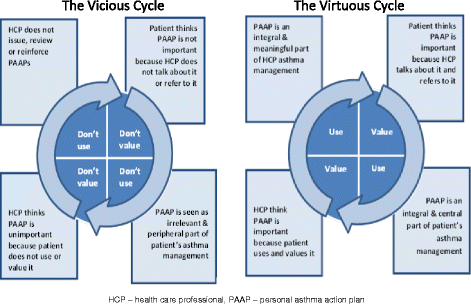The 'vicious cycle' of personalised asthma action plan implementation in primary care: a qualitative study of patients and health professionals' views
- PMID: 26487557
- PMCID: PMC4618358
- DOI: 10.1186/s12875-015-0352-4
The 'vicious cycle' of personalised asthma action plan implementation in primary care: a qualitative study of patients and health professionals' views
Abstract
Background: Personal asthma action plans (PAAPs) have been guideline recommended for years, but consistently under-issued by health professionals and under-utilised by patients. Previous studies have investigated sub-optimal PAAP implementation but more insight is needed into barriers to their use from the perspective of professionals, patients and primary care teams.
Methods: A maximum variation sample of professional and patient participants were recruited from five demographically diverse general practices and another group of primary care professionals in one Scottish region. Interviews were digitally recorded and data thematically analysed using NVivo.
Results: Twenty-nine semi-structured interviews were conducted (11 adults with asthma, seven general practitioners, ten practice nurses, one hospital respiratory nurse). Three over-arching themes emerged: 1) patients generally do not value PAAPs, 2) professionals do not fully value PAAPs and, 3) multiple barriers reduce the value of PAAPs in primary care. Six patients had a PAAP but these were outdated, not reflecting their needs and not used. Patients reported not wanting or needing PAAPs, yet identified circumstances when these could be useful. Fifteen professionals had selectively issued PAAPs with eight having reviewed one. Many professionals did not value PAAPs as they did not see patients using these and lacked awareness of times when patients could have benefited from one. Multi-level compounding barriers emerged. Individual barriers included poor patient awareness and professionals not reinforcing PAAP use. Organisational barriers included professionals having difficulty accessing PAAP templates and fragmented processes including patients not being asked to bring PAAPs to their asthma appointments.
Conclusions: Primary care PAAP implementation is in a vicious cycle. Professionals infrequently review/update PAAPs with patients; patients with out-dated PAAPs do not value or use these; professionals observing patients' lack of interest in PAAPs do not discuss these. Patients observing this do not refer to their plans and perceive them to be of little value in asthma self-management. Twenty-five years after PAAPs were first recommended, primary care practices are still not ready to support their implementation. Breaking this vicious cycle to create a healthcare context more conducive to PAAP implementation requires a whole systems approach with multi-faceted interventions addressing patient, professional and organisational barriers.
Figures
References
-
- Woolcock A, Rubinfeld A, Seale J, Landau L, Antic R, Mitchell C, et al. Asthma management plan. Med J Australia. 1989;151:650–3. - PubMed
-
- Gibson P, Powell H, Coughlan J, Wilson A, Abramson M, Haywood P, Bauman A, Hensley M, Walters E, Roberts J: Self-management education and regular practitioner review for adults with asthma. Cochrane Database of Systematic Reviews: 2009, Issue 3. DOI: 10.1002/14651858.CD001117 - PubMed
Publication types
MeSH terms
Grants and funding
LinkOut - more resources
Full Text Sources
Other Literature Sources
Medical


